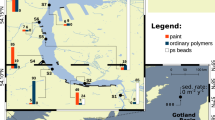Abstract
The dispersion of fine sediment is greatly influenced by factors that induce flocculation, and which thereby determine whether particulates will settle in aggregate form or as discrete grains. The transport and deposition of silt and clay particulates in both marine and non-marine environments may be influenced by flocculation. Because the transport of sediment-associated contaminants is largely influenced by the behaviour of sub sand-size material, it is important to understand the factors which influence patterns of deposition. The silt/clay ratio has been used in an attempt to simplify description of the physical processes of sediment/water interaction, and most examples have been drawn from the Great Lakes. The silt/clay ratio has been related to other characteristics of the total particle-size distribution. As an indicator of many sedimentary conditions, it must be coupled with other measurements of particle-size.
Similar content being viewed by others
References
Damiani, V., 1972. Studio di un ambiente fluvio-lacustre sulla base di una analisi granulometrica dei sediment: Fiume Toce e bacino della Isole Borromee (Lago Maggiore). Mem. Inst. Ital. Idrobiol. 29: 37–95.
Gibbs, R. J., 1985. Settling velocity, diameter, and density for flocs of illite, kaolinite and montmorillonite. J. Sed. Petrol. 55: 65–68.
Grant, A. C., 1970. Distributional trends in the Recent marine sediments of northern Baffin Bay. Maritime Sediments 7: 41–63.
Knight, R. J., 1971. Distributional trends in Recent marine sediments of Tasiujac Cove of Ekalugad Fjord, Baffin Island, N. W. T. Maritime Sediments 7: 1–18.
Kranck, K., 1980. Experiments on the significance of flocculation in the settling of fine-grained sediment in still water. Can. J. Earth Sci. 17: 1517–1526.
Middleton, G. V., 1976. Hydraulic interpretation of sand size distributions. J. Geology 84: 405–426.
Passega, R., 1977. Significance of CM diagrams of sediments deposited by suspensions. Sedimentology 24: 723–733.
Pelletier, B. R., 1973. A re-examination of the use of the silt/clay ratios as indicators of sedimentary environments: a study for students. Maritime Sediments 9: 1–12.
Rosa, F., 1985. Sedimentation and sediment resuspension in Lake Ontario. J. Great Lakes Res. 11: 13–25.
Sandilands, R. G. & A. Murdroch, 1983. Nepheloid layer in Lake Ontario. J. Great Lakes Res. 9: 190–200.
Sherman, I., 1953. Flocculent structure of sediment suspended in Lake Mead. Trans. Am. Geophys. Union 34: 394–406.
Sly, P. G., 1969. Sedimentological studies in the Niagara area of Lake Ontario, and in the area immediately north of the Bruce Peninsula in Georgian Bay. In Proc. 12th. Conf. Great Lakes Res. pp. 341–346. Int. Ass. Great Lakes Res.
Sly, P. G., 1983. Recent sediment stratigraphy and geotechnical characteristics of foreset and bottomset beds of the Niagara Bar. J. Great Lakes Res. 9: 224–233.
Sly, P. G., 1983. Sedimentology and geochemistry of Recent sediments off the mouth of the Niagara River, Lake Ontario. J. Great Lakes Res. 9: 134–159.
Sly, P. G., 1984. Sedimentology and geochemistry of modern sediments in the Kingston basin of Lake Ontario. J. Great Lakes Res. 10: 358–374.
Sly, P. G. (this volume). Sediment dispersion: Part 2, characterization by size of sand fraction and percent mud.
Sly, P. G., R. L. Thomas & B. R. Pelletier, 1983. Interpretation of moment measures derived from water-lain sediments. Sedimentology 30: 219–233.
Thomas, R. L., A. L. W. Kemp & C. F. M. Lewis, 1972. Distribution, composition and characteristics of the surficial sediments of Lake Ontario. J. Sed. Petrol. 42: 66–84.
Thomas, R. L., A. L. W. Kemp & C. F. M. Lewis, 1973. The surficial sediments of Lake Huron. Can. J. Earth Sci. 10: 226–271.
Visher, G. S., 1969. Grain size distribution and depositional process. J. Sed. Petrol., 39: 1074–1106.
Author information
Authors and Affiliations
Rights and permissions
About this article
Cite this article
Sly, P.G. Sediment dispersion: part 1, fine sediments and significance of the silt/clay ratio. Hydrobiologia 176, 99–110 (1989). https://doi.org/10.1007/BF00026547
Issue Date:
DOI: https://doi.org/10.1007/BF00026547




